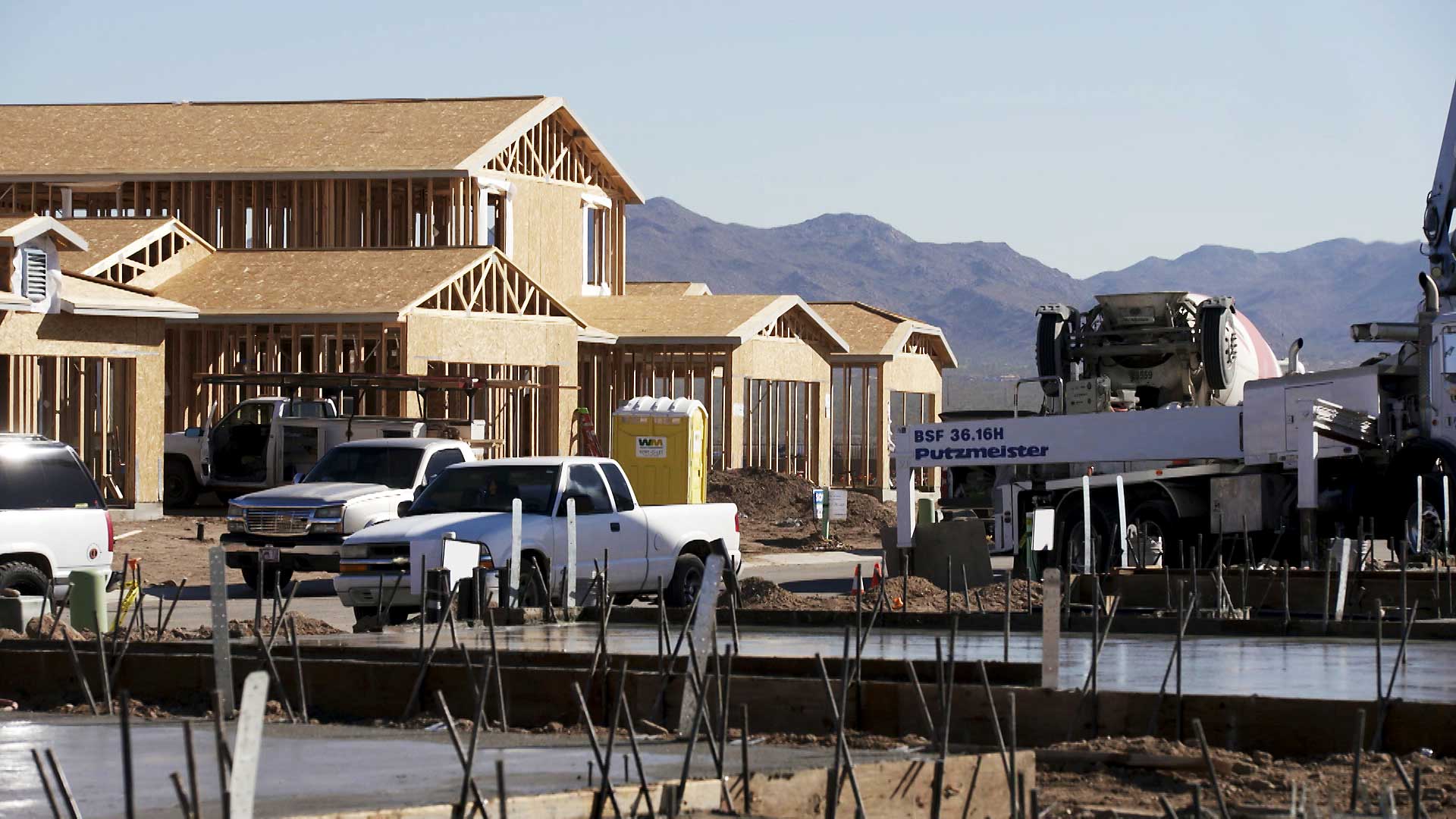 A home under construction in Marana in a development owned by Meritage Homes. March 2021.
A home under construction in Marana in a development owned by Meritage Homes. March 2021.
The Buzz for May 24, 2024

This episode is the last of three that are a part of AZPM's reporting series Where to Live?
As Southern Arizona's housing crisis deepens, those who help people who don't have a home are seeing trends in who they are serving.
"We see a full range of individuals and families and children who are experiencing homelessness. The trend however, from what the data is showing us in regards to our unhoused population here in southern Arizona is we're seeing a trend of increasingly older individuals and younger individuals," said Tisha Tallman, CEO of the Primavera Foundation.
Tallman and others say increasing rental rates are a major issue that is pushing people out of their homes.
"Developers are coming in and putting some new linoleum and paint on the walls and calling it a $1,400-$1,500 one bedroom apartment. People that are getting $800, $900, $1,200 a month just can't afford that. So we're seeing some first time homeless folks, and quite frankly, they're embarrassed," said Brandi Champion, Housing First Director for the City of Tucson and a member of the Tucson Pima Collaboration to End Homelessness Continuum of Care Board.
While this is a cohort that is growing, it is not the only group. They join other groups who have long struggled with housing such as those who struggle with mental health or addiction, or those who lack solid employment.
"What the main cause of homelessness is, is a catastrophic loss of family," Champion said. "So these people are then turned away at the family level, or they lose a spouse, God forbid that person's not working or doesn't have a source of income. And where do they go? They go to the street."
While family may be an issue, another is a lack of community involvement in the effort to keep people housed.
"A lot of the supports that help people remain stably housed for the long term happen out in the community. So it's their access to services, different sorts of things like food pantries, whatever it might be, that really is important for a comprehensive approach. So getting people into housing is one step of the process, but creating communities where there's kind of backstops and fail safes for folks, so they don't actually exit," said Atticus Jaramillo, a housing policy professor at the University of Arizona. Tallman said the effort to help unhoused people has been happening for decades, but the efforts that have been tried barely moved the needle.
"I think now we're at a point where we're looking at it differently, right? It's not just about providing the band aid. It's not just about providing services, it's providing those supports that people need and that people ask for. That's the dignity, belonging and power and autonomy, we need to include people in decision making. So it's no longer just providing what us as providers think that individuals need. It's us co creating solutions, with our participants, with our residents."
Those efforts to be more flexible in the help that is offered, according to Jaramillo, can make a larger difference.
"That's one of the exciting things that I think is finally coming and becoming popularized is this idea that historically, there's been more access to traditional services like jobs training, healthcare. And really, I think what's become clear in the last 10-15 years is that little things matter quite a bit. So it's things like eviction protection. And it's things like helping people get furniture for their home, like feeling like they have control over their living space is really important for them to think about it as a home, not just another sort of way station."
While there are populations who traditionally struggle with staying housed, there is growth in southern Arizona of those who cannot find a place they can afford.
As the cost of building goes up, so do home prices
The area's recent population boom has put upward pressure on home prices for both purchase and rental properties.
And while demand has increased, supply remains an issue. The cost of building new homes, be they single- or multi-family, has gone up.
"We like to talk about the five L's: land, labor, lumber, legislation or the local political regulatory environment, and lending. And I think you've seen huge changes in those areas over the past few years. And so that's all really driving the price of housing," said David Godlewski, President and CEO of the Southern Arizona Home Builders Association.
Land and labor have posed an issue. Godlewski said that those who own buildable land have been "very patient" while waiting for prices to rise. And data from the Arizona Office of Economic Opportunity shows the number of construction jobs in the state has nearly doubled since 2010 to more than 200,000 workers.
"Material prices are still elevated in the numbers that I've seen for homebuilding. Lumber specifically, is somewhere in the range of 30 to $35,000 per home. Just In terms of the cost of lumber. That doesn't include you touched on steel, gypsum, any of the other type of materials," he said.
On the legislative end, construction code changes such as required energy efficiency improvements are pushing the price of building upward also.
Jim Tofel of Tofel Dent Construction, a firm that counts multi-family housing developments among its projects, said an apartment complex the company built in Sierra Vista illustrates this.
"Our per unit cost [one a phase built in 2012] was about about $78,000, a door. Phase two started in 2022. And our per unit cost went to $257,000 a door, and these units were identical. So on the surface, it looks like there was about 300% inflation over a decade. But when you dig below the surface, there's really more going on than that. Our slab was an inch and a half thicker, there was more post-tension cables. Our exterior walls went from 2x4 to 2x6. Instead of R13, and insulation, you had R19 insulation. There were better windows, better air conditioners, better water heaters."
Lending has also played a pivotal role in changing what can be built.
"A developer told me about two years ago that for every tenth of a point interest rates go up on a 200 unit apartment complex. He's got to come up with $300,000. And so you start doing the math, if you have a 200 unit apartment complex, and interest rates have gone up 3%, that's an extra $10 million of equity that has to be brought to the table," said Tofel.
Tofel estimates that a new multi-family development takes 5-7 years from the earliest phases of design and planning to the day residents can move in. Godlewski said a new home development can take around two years.
The demand for homes has gone up notably quicker than supply. Pima County has grown by around 10,000 people a year on average since 2019, according to state demographers. And the Phoenix area has grown even quicker.
As homebuilders struggle to keep up, home prices grow.
"Our price increases since pre-COVID through the state have gone up almost probably 60%," said Tucson Association of Realtors President Cathy Wolfson. "And then you have the interest rate hike on top of that. The interest rate actually isn't bad. I mean, it's a pretty normal rate. It's just, we just got to catch up with it."
At its peak, Wolfson said homes were on the resale market for days, if not hours. Conditions have slowed, but there is still a lack of inventory on the market.
"A house is on the market for about 30 to 40 days [typically now]. If a house that's priced well, shows well, and everything else could go still go very fast. But you might not have 50 offers like we had before. You actually might have time to go back and see it again. It's relaxed a little bit, we still need more houses, we need affordable housing." Wolfson said houses do still come on the market, but she thinks interest rates are not the biggest issue.
"People will start leaving. Things happen in lives that are normal, and they will start leaving. But right now they're pretty locked in. Then when the home prices went up, it's kind of hard to believe that [they'll move], with higher interest rates, and whatnot. But we need to build more houses. That's our answer."



By submitting your comments, you hereby give AZPM the right to post your comments and potentially use them in any other form of media operated by this institution.